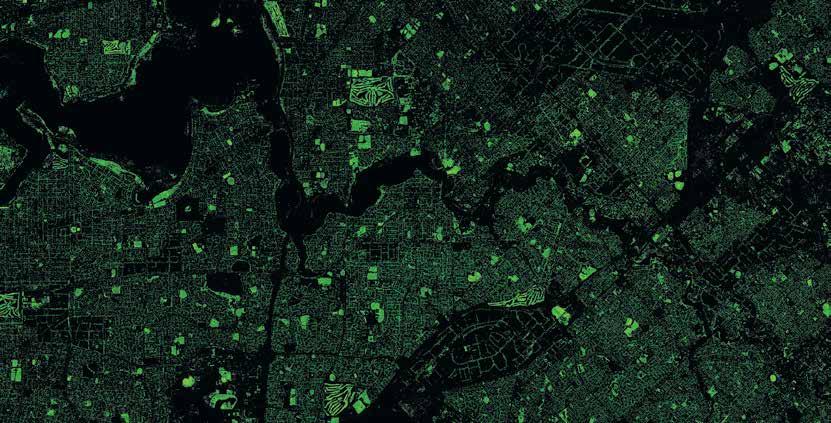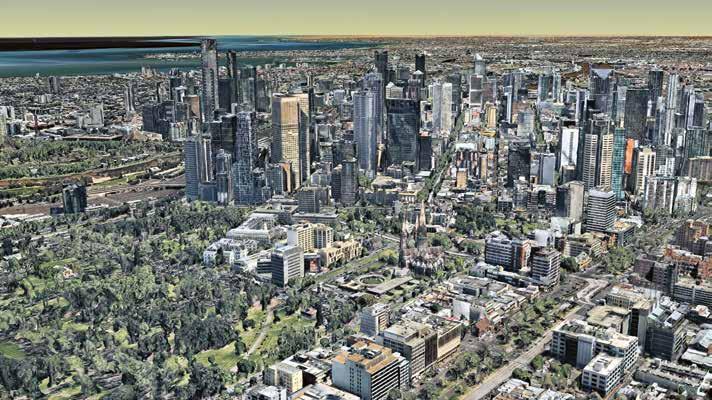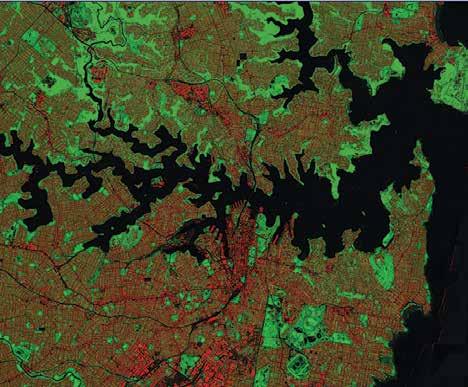
4 minute read
3D mapping
HOW CAN NEARMAP’S 3D MAPS AND AI HELP CONSTRUCTION?
ROADS & INFRASTRUCTURE SPOKE TO SHANE PRESTON, NEARMAP’S EXECUTIVE VICE PRESIDENT SALES, TO FIND OUT HOW ITS NEW 3D PRODUCT AND AI TECHNOLOGY WILL IMPACT THE ROADS AND INFRASTRUCTURE INDUSTRIES.
We live in a three-dimensional world, so why should the construction industry try solving 3D challenges with 2D content?
This is one of the leading questions behind Australian aerial imagery company Nearmap’s new browser-based product, Nearmap 3D.
The company began as a small online startup in Perth and has now become an ASX200 technology company, with more than 80 staff dedicated to research and development. It specialises in capturing aerial images, which are crisper and more frequently updated than satellite images, and provides them to business and governments.
Thousands of photos are taken each day from a plane and stitched together to create detailed images of what’s on the ground, which subscribers can access on a web browser. It now has the capability to visualise cities in 3D. Shane Preston, Nearmap’s Executive Vice President Sales, says this has the potential to fundamentally change how construction, architecture, urban planning, local

Melbourne visualised in 3D.
governments and councils shape cities across Australia and the Unites States.
“The 3D models Nearmap has created help users visualise and add context at each stage of the design process,” he says. “For example, architects, engineers and geospatial professionals can easily see how a proposed project or design will interact with its environment. We have found it is particularly helpful in the preconstruction, feasibility and pre-design phases, allowing businesses to respond quickly to requests for proposals.”
Nearmap 3D gives users the ability to measure distance, height, width and pitch within the application. Users are also able to size up an area and export up to 50 square kilometres of space, which can be downloaded in a matter of minutes or hours depending on the size of the footprint, and then used across a wide range of other design programs. Across Australia, 22,890 square kilometres of land have been captured and are available on the app, including 12 major urban areas. The 3D imagery has already been used by a Sydney-based council undergoing major development. Currently, the local government has an eight-storey limit in its central business district but had multiple proposals from developers for 30-storey towers. The local council was able to use Nearmap’s 3D models to visualise how these developments could potentially impact the surrounding community.
Mr. Preston says a core part of the design philosophy was making the technology so simple that anyone could use it.
“It was really important to us that we had insanely simple adoption. There’s no point of having all this amazing content if it’s difficult to access,” he says.
“That’s why we made sure it was easy to get our data into the hands of 3D experts and novices alike. For people who do complex analysis with sophisticated software, Nearmap 3D enables to easily export the 3D content and bring it into other programs.’’
Nearmap aims to make its content accessible to organisations of all sizes, from a small family business to a multinational infrastructure giant. It is part of the company’s goal to democratise 3D content. This can be important for smaller builders, which may not have the resources to access technology such as drones or helicopters in order to create their own 3D models.
“Traditionally, 3D content has had significant requirements that make it inaccessible to smaller builders. For example, if an organisation needs to get 3D content of a project area, it could take days or weeks in order to get it,” Preston says.
“Now, subscribers can get that information within minutes, letting them respond quicker to deadlines and bids. Improving construction productivity is vital, especially with the amount of money being spent on infrastructure each year. We can’t afford to use the same technology and methods we used 10, two or even one year ago.”
Alongside the announcement of Nearmap 3D, the company is also launching the beta of its Artificial Intelligence (AI) product. After two years of research and development, the
Nearmap 3D gives users the ability to measure distance, height, width and pitch.

company has built machine learning models and deployed them on a wide scale.
Millions of aerial images, captured multiple times a year over a decade, have now been turned into datasets which can be used to accurately measure change and quantify attributes, such as construction activity, solar panels, roofs or pools.
It aims to reduce the amount of site visits, generate more leads, and reduce the time involved when inspecting properties manually. Mr. Preston says the two main functions of the AI system are change identification and object identification.
“Up until now, our customers have beenusing their eyes to identify objects and how a certain area of land changed over time. By using cloud computing, AI and our data, they’ll be able to do it much more effectively,” he explains. ‘’Construction companies could use it to find car parking spaces, road hardware, or identify what’s changed on a construction site over the years.’’ While still in beta, the Nearmap AI product aims to level the playing field for companies that wouldn’t be able to access this type of data. The company is hoping to get feedback from the market to learn what it needs to add for the next stages.










